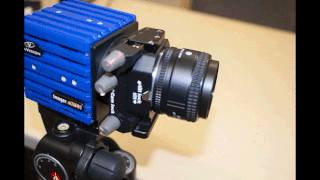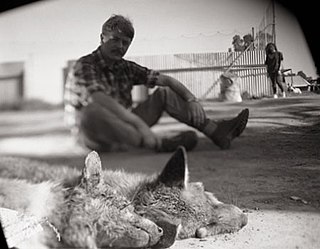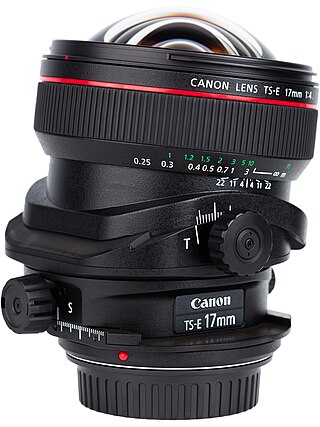
A single-lens reflex camera (SLR) is a camera that typically uses a mirror and prism system that permits the photographer to view through the lens and see exactly what will be captured. With twin lens reflex and rangefinder cameras, the viewed image could be significantly different from the final image. When the shutter button is pressed on most SLRs, the mirror flips out of the light path, allowing light to pass through to the light receptor and the image to be captured.

A view camera is a large-format camera in which the lens forms an inverted image on a ground-glass screen directly at the film plane. The image is viewed, composed, and focused, then the glass screen is replaced with the film to expose exactly the same image seen on the screen.

A camera lens is an optical lens or assembly of lenses used in conjunction with a camera body and mechanism to make images of objects either on photographic film or on other media capable of storing an image chemically or electronically.

A telephoto lens, also known as telelens, is a specific type of a long-focus lens used in photography and cinematography, in which the physical length of the lens is shorter than the focal length. This is achieved by incorporating a special lens group known as a telephoto group that extends the light path to create a long-focus lens in a much shorter overall design. The angle of view and other effects of long-focus lenses are the same for telephoto lenses of the same specified focal length. Long-focal-length lenses are often informally referred to as telephoto lenses, although this is technically incorrect: a telephoto lens specifically incorporates the telephoto group.
Panoramic photography is a technique of photography, using specialized equipment or software, that captures images with horizontally elongated fields of view. It is sometimes known as wide format photography. The term has also been applied to a photograph that is cropped to a relatively wide aspect ratio, like the familiar letterbox format in wide-screen video.

A Schmidt camera, also referred to as the Schmidt telescope, is a catadioptric astrophotographic telescope designed to provide wide fields of view with limited aberrations. The design was invented by Bernhard Schmidt in 1930.

The Scheimpflug principle is a description of the geometric relationship between the orientation of the plane of focus, the lens plane, and the image plane of an optical system when the lens plane is not parallel to the image plane. It is applicable to the use of some camera movements on a view camera. It is also the principle used in corneal pachymetry, the mapping of corneal topography, done prior to refractive eye surgery such as LASIK, and used for early detection of keratoconus. The principle is named after Austrian army Captain Theodor Scheimpflug, who used it in devising a systematic method and apparatus for correcting perspective distortion in aerial photographs, although Captain Scheimpflug himself credits Jules Carpentier with the rule, thus making it an example of Stigler's law of eponymy.

A catadioptric optical system is one where refraction and reflection are combined in an optical system, usually via lenses (dioptrics) and curved mirrors (catoptrics). Catadioptric combinations are used in focusing systems such as searchlights, headlamps, early lighthouse focusing systems, optical telescopes, microscopes, and telephoto lenses. Other optical systems that use lenses and mirrors are also referred to as "catadioptric", such as surveillance catadioptric sensors.

The Maksutov is a catadioptric telescope design that combines a spherical mirror with a weakly negative meniscus lens in a design that takes advantage of all the surfaces being nearly "spherically symmetrical". The negative lens is usually full diameter and placed at the entrance pupil of the telescope. The design corrects the problems of off-axis aberrations such as coma found in reflecting telescopes while also correcting chromatic aberration. It was patented in 1941 by Soviet optician Dmitri Dmitrievich Maksutov. Maksutov based his design on the idea behind the Schmidt camera of using the spherical errors of a negative lens to correct the opposite errors in a spherical primary mirror. The design is most commonly seen in a Cassegrain variation, with an integrated secondary, that can use all-spherical elements, thereby simplifying fabrication. Maksutov telescopes have been sold on the amateur market since the 1950s.

The Cassegrain reflector is a combination of a primary concave mirror and a secondary convex mirror, often used in optical telescopes and radio antennas, the main characteristic being that the optical path folds back onto itself, relative to the optical system's primary mirror entrance aperture. This design puts the focal point at a convenient location behind the primary mirror and the convex secondary adds a telephoto effect creating a much longer focal length in a mechanically short system.

Tilt–shift photography is the use of camera movements that change the orientation or position of the lens with respect to the film or image sensor on cameras.

Jules Carpentier was a French engineer and inventor.

Tilted plane photography is a method of employing focus as a descriptive, narrative or symbolic artistic device. It is distinct from the more simple uses of selective focus which highlight or emphasise a single point in an image, create an atmospheric bokeh, or miniaturise an obliquely-viewed landscape. In this method the photographer is consciously using the camera to focus on several points in the image at once while de-focussing others, thus making conceptual connections between these points.
The Canon TS-E 24 mm f/3.5L II is a tilt-shift, wide-angle prime lens that provides the equivalent of the corresponding view camera front movements on Canon EOS camera bodies. Though it uses Canon's EF lens mount, it does not provide autofocus.

The Canon TS-E 45 mm f/2.8 is a tilt-shift, normal prime lens that provides the equivalent of the corresponding view camera front movements on Canon EOS camera bodies. Unlike most other EF-mount lenses, it does not provide autofocus.
The Canon TS-E 90 mm f/2.8 is a tilt-shift, telephoto prime lens that provides the equivalent of the corresponding view camera front movements on Canon EOS camera bodies. Unlike most other EF-mount lenses, it does not provide autofocus.
The design of photographic lenses for use in still or cine cameras is intended to produce a lens that yields the most acceptable rendition of the subject being photographed within a range of constraints that include cost, weight and materials. For many other optical devices such as telescopes, microscopes and theodolites where the visual image is observed but often not recorded the design can often be significantly simpler than is the case in a camera where every image is captured on film or image sensor and can be subject to detailed scrutiny at a later stage. Photographic lenses also include those used in enlargers and projectors.

The Canon TS-E 17 mm f/4L is a tilt-shift, ultra-wide-angle prime lens that provides the equivalent of the corresponding view camera front movements on Canon EOS camera bodies. Unlike most other EF-mount lenses, it does not provide autofocus.
The Canon TS-E 50 mm f/2.8L MACRO is a tilt-shift prime lens that provides the equivalent of the corresponding view camera front movements on Canon EOS camera bodies. Unlike most other EF-mount lenses, it does not provide autofocus.
The Canon TS-E 135 mm f/4L MACRO is a tilt-shift, Macro prime lens that provides the equivalent of the corresponding view camera front movements on Canon EOS camera bodies. Unlike most other EF-mount lenses, it does not provide autofocus.













